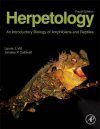Textbook
By: Laurie J Vitt(Author), Janalee P Caldwell(Author)
757 pages, colour & b/w photos, colour & b/w illustrations, colour distribution maps, colour tables
![Herpetology Herpetology]()
Click to have a closer look
About this book
Contents
Customer reviews
Related titles
About this book
Amphibians and reptiles have assumed a central role in research because of the diversity of ecological, physiological, morphological, behavioral, and evolutionary patterns they exhibit. The fourth edition of the textbook Herpetology: An Introductory Biology of Amphibians and Reptiles covers the basic biology of these fascinating animals with updates in nearly every conceptual area.
Herpetology: An Introductory Biology of Amphibians and Reptiles not only serves as a solid foundation for modern herpetology courses, but is also relevant to courses in ecology, behavior, evolution, systematics, and morphology. Examples taken from amphibians and reptiles throughout the world make Herpetology: An Introductory Biology of Amphibians and Reptiles useful as a herpetology textbook in several countries. Naturalists, amateur herpetologists, herpetoculturists, zoo professionals, and many others will find this book readable and full of relevant natural history and distributional information. Much research in the past few years has been done in squamates (lizards and snakes), particularly with regard to their taxonomy.
This fully revised fourth edition brings the latest research to the reader and keeps current with a quickly moving field, including the addition of many new photographs from the authors' own massive image library. It is heavily revised and updated with fully updated discussion of squamate taxonomy and new content reflected in current literature. It has more focus on conservation biology in herpetology while retaining solid content on organismal biology of reptiles and amphibians. It presents new photos that are included from the authors' extensive library.
Contents
Part I. Evolutionary History
1. Tetrapod Relationships and Evolutionary Systematics
2. Anatomy of Amphibians and Reptiles
3. Evolution of Ancient and Modern Amphibians and Reptiles
Part II. Reproduction and Reproductive Modes
4. Reproduction and Life Histories
5. Reproductive Modes
Part III. Physiological Ecology
6. Water Balance and Gas Exchange
7. Thermoregulation, Performance, and Energetics
Part IV. Behavioral Ecology
8. Spacing, Movements, and Orientation
9. Communication and Social Behavior
10. Foraging Ecology and Diets
11. Defense and Escape
Part V. Ecology, Biogeography, and Conservation Biology
12. Ecology
13. Biogeography and Phylogeography
14. Conservation Biology
Part VI. Classification and Diversity of Amphibians
Introduction
15. Caecilians
16. Salamanders
17. Frogs
Part VII. Classification and Diversity of Reptiles
Introduction
18. Turtles
19. Crocodylians
20. Sphenodontidans
21. Squamates (Snakes and Lizards)
Part VIII. Data Sources
Bibliography
Glossary
Taxonomic Index
Subject Index
Customer Reviews
Textbook
By: Laurie J Vitt(Author), Janalee P Caldwell(Author)
757 pages, colour & b/w photos, colour & b/w illustrations, colour distribution maps, colour tables


































